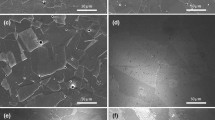Abstract
The degree of sensitization (DOS) of austenitic stainless steels and some nickel-based alloys (e.g., alloy 600) is evaluated by the electrochemical potentiokinetic reactivation (EPR) test. In this study a number of test solutions based on H2SO4 + KSCN composition have been evaluated to establish a reliable EPR test method for alloy 800. Different passivation (vertex) potentials are also tested. It has been shown that dilute test solutions with lower vertex potentials resulted in single loop (SL) and double loop (DL) EPR test methods that distinguished between different sensitized samples and also between sensitized and desensitized samples. It has been shown that an SL-EPR test in 1 M H2SO4 + 0.002 M KSCN (de-aerated) at 26 °C at a scan rate of 3 mV/s from a vertex potential of 700 mVSCE (180 s hold time) gave results that matched with the DOS indicated by microstructures and the Huey test results. Similarly, the DL-EPR test in 1 M H2SO4 + 0.002 M KSCN (de-aerated) at 26 °C, forward scanning from the OCP to + 700 mVSCE and then backward scanning from there to the OCP at a scan rate of 2 mV/s produced a good measure of DOS as indicated by the Huey test results. The effectiveness of the EPR test was ascertained by testing on alloy 800 containing Ti and Al (alloy 800 HT) and Nb (alloy 800 Nb).
Similar content being viewed by others
References
S.J. Green and P.N. Paine: “Materials Performance in Nuclear Pressurized Water Reactor Steam Generators,” Nucl. Technol., 1981, 55, pp. 10–29.
J.E. Chafely and D.J. Roberts: “Steam Generator Materials Performance in High Temperature Gas Cooled Reactors,” Nucl. Technol., 1981, 55, pp. 37–49.
P.J. King and D.P. Dautovich: “Pitting Corrosion of Nuclear Steam Generator Materials,” Nucl. Technol., 1981, 55, pp. 196–206.
O.S. Tatone, P. Meindl, and G.F. Taylor: “Steam Generator Tube Performance: Experience With Water Cooled Nuclear Power Reactors During 1983 and 1984,” Nucl. Safety, 1987, 28(3), p. 374.
V.J. Cihal, V. Cihal, and D.J. Maja: “Detection of Low Temperature Sensitization of Alloy 800 With STEM Phillips EM 430,” J. Phys., 1993, 3, pp. 89–92, Colloque C7.
W.L. Clarke, R.L. Cowan, and W.L. Walker: “Comparative Methods for Measuring Degree of Sensitization in Stainless Steel, Intergranular Corrosion of Stainless Alloys” in ASTM STP 656, R.F. Steigerwald, ed., ASTM, Philadelphia, PA, 1978, pp. 99–132.
W.L. Clarke: The EPR Method for Detection of Sensitization in Stainless Steels, US Nuclear Regulatory Commission Report, NUREG/CR-1095, 1981.
L. Edgemon, M. Marek, D.F. Wilson, and G.E.C. Bell: “Sensitization Behavior of Alloy 800H as Characterized by Electrochemical Potentiokinetic Reactivation (EPR) Technique,” Corrosion, 1994, 50, pp. 912–18.
Y. Watanabe, R.G. Ballinger, O.K. Harling, and G.E. Kohse: “Effects of Neutron Irradiation on Transpassive Corrosion Behavior of Austenitic Stainless Steels,” Corrosion, 1995, 51(9), pp. 651–59.
V. Kain and Y. Watanabe: “Development of a Single Loop EPR Test Method and Its Relation to Grain Boundary Microchemistry for Alloy 600,” J. Nucl. Mater., 2002, 30(2), No. 1, pp. 49–59.
Author information
Authors and Affiliations
Rights and permissions
About this article
Cite this article
Ahemadabadi, P., Kain, V., Singh, P.R. et al. Development of EPR test technique for alloy 800. J. of Materi Eng and Perform 12, 529–536 (2003). https://doi.org/10.1361/105994903100277184
Received:
Issue Date:
DOI: https://doi.org/10.1361/105994903100277184



